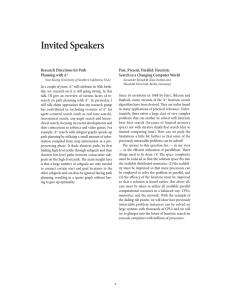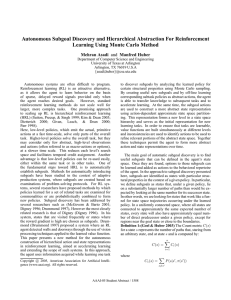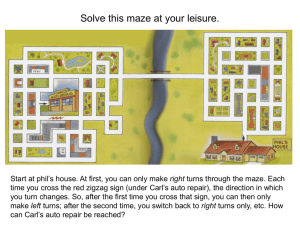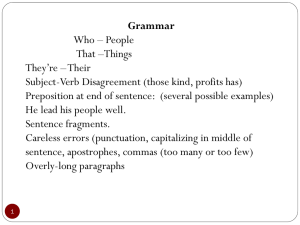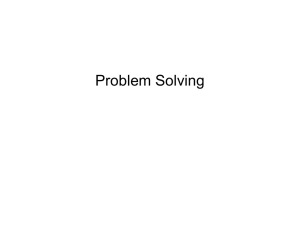Subgoal Graphs for Optimal Pathfinding in Eight-Neighbor Grids Tansel Uras Sven Koenig
advertisement
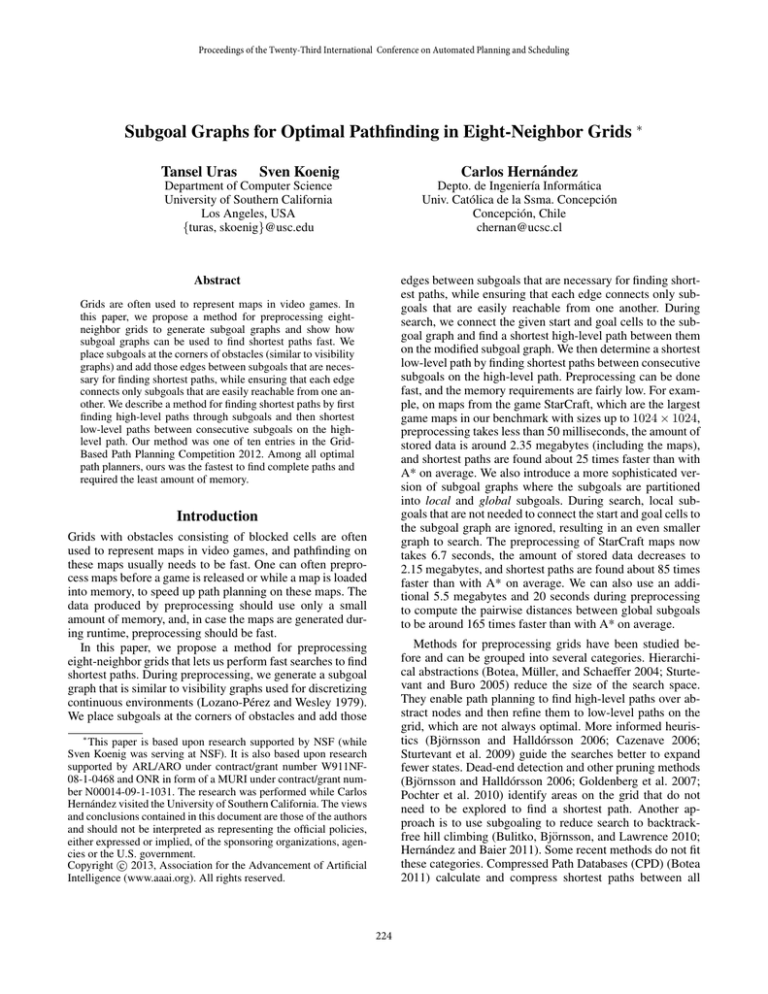
Proceedings of the Twenty-Third International Conference on Automated Planning and Scheduling
Subgoal Graphs for Optimal Pathfinding in Eight-Neighbor Grids ∗
Tansel Uras
Carlos Hernández
Sven Koenig
Depto. de Ingenierı́a Informática
Univ. Católica de la Ssma. Concepción
Concepción, Chile
chernan@ucsc.cl
Department of Computer Science
University of Southern California
Los Angeles, USA
{turas, skoenig}@usc.edu
Abstract
edges between subgoals that are necessary for finding shortest paths, while ensuring that each edge connects only subgoals that are easily reachable from one another. During
search, we connect the given start and goal cells to the subgoal graph and find a shortest high-level path between them
on the modified subgoal graph. We then determine a shortest
low-level path by finding shortest paths between consecutive
subgoals on the high-level path. Preprocessing can be done
fast, and the memory requirements are fairly low. For example, on maps from the game StarCraft, which are the largest
game maps in our benchmark with sizes up to 1024 × 1024,
preprocessing takes less than 50 milliseconds, the amount of
stored data is around 2.35 megabytes (including the maps),
and shortest paths are found about 25 times faster than with
A* on average. We also introduce a more sophisticated version of subgoal graphs where the subgoals are partitioned
into local and global subgoals. During search, local subgoals that are not needed to connect the start and goal cells to
the subgoal graph are ignored, resulting in an even smaller
graph to search. The preprocessing of StarCraft maps now
takes 6.7 seconds, the amount of stored data decreases to
2.15 megabytes, and shortest paths are found about 85 times
faster than with A* on average. We can also use an additional 5.5 megabytes and 20 seconds during preprocessing
to compute the pairwise distances between global subgoals
to be around 165 times faster than with A* on average.
Grids are often used to represent maps in video games. In
this paper, we propose a method for preprocessing eightneighbor grids to generate subgoal graphs and show how
subgoal graphs can be used to find shortest paths fast. We
place subgoals at the corners of obstacles (similar to visibility
graphs) and add those edges between subgoals that are necessary for finding shortest paths, while ensuring that each edge
connects only subgoals that are easily reachable from one another. We describe a method for finding shortest paths by first
finding high-level paths through subgoals and then shortest
low-level paths between consecutive subgoals on the highlevel path. Our method was one of ten entries in the GridBased Path Planning Competition 2012. Among all optimal
path planners, ours was the fastest to find complete paths and
required the least amount of memory.
Introduction
Grids with obstacles consisting of blocked cells are often
used to represent maps in video games, and pathfinding on
these maps usually needs to be fast. One can often preprocess maps before a game is released or while a map is loaded
into memory, to speed up path planning on these maps. The
data produced by preprocessing should use only a small
amount of memory, and, in case the maps are generated during runtime, preprocessing should be fast.
In this paper, we propose a method for preprocessing
eight-neighbor grids that lets us perform fast searches to find
shortest paths. During preprocessing, we generate a subgoal
graph that is similar to visibility graphs used for discretizing
continuous environments (Lozano-Pérez and Wesley 1979).
We place subgoals at the corners of obstacles and add those
Methods for preprocessing grids have been studied before and can be grouped into several categories. Hierarchical abstractions (Botea, Müller, and Schaeffer 2004; Sturtevant and Buro 2005) reduce the size of the search space.
They enable path planning to find high-level paths over abstract nodes and then refine them to low-level paths on the
grid, which are not always optimal. More informed heuristics (Björnsson and Halldórsson 2006; Cazenave 2006;
Sturtevant et al. 2009) guide the searches better to expand
fewer states. Dead-end detection and other pruning methods
(Björnsson and Halldórsson 2006; Goldenberg et al. 2007;
Pochter et al. 2010) identify areas on the grid that do not
need to be explored to find a shortest path. Another approach is to use subgoaling to reduce search to backtrackfree hill climbing (Bulitko, Björnsson, and Lawrence 2010;
Hernández and Baier 2011). Some recent methods do not fit
these categories. Compressed Path Databases (CPD) (Botea
2011) calculate and compress shortest paths between all
∗
This paper is based upon research supported by NSF (while
Sven Koenig was serving at NSF). It is also based upon research
supported by ARL/ARO under contract/grant number W911NF08-1-0468 and ONR in form of a MURI under contract/grant number N00014-09-1-1031. The research was performed while Carlos
Hernández visited the University of Southern California. The views
and conclusions contained in this document are those of the authors
and should not be interpreted as representing the official policies,
either expressed or implied, of the sponsoring organizations, agencies or the U.S. government.
c 2013, Association for the Advancement of Artificial
Copyright Intelligence (www.aaai.org). All rights reserved.
224
A
pairs of cells during preprocessing and therefore avoid
searching altogether during runtime. However, their memory requirements can be high even with high compression
factors. Symmetry reducing methods (Harabor and Grastien
2010) identify and eliminate path symmetries on grids. For
example, Jump Point Search (JPS) (Harabor and Grastien
2011) performs symmetry reduction during runtime (without any preprocessing) to find shortest paths faster than
Hierarchical Pathfinding A* (Botea, Müller, and Schaeffer
2004).
Our method is a hybrid between hierarchical abstractions
and symmetry reducing methods: It is hierarchical because
we first find a high-level path and then refine it to a low-level
path. It is symmetry reducing because an edge of the subgoal graph can correspond to many shortest paths between
the subgoals that it connects (which cannot happen on visibility graphs because the straight line between vertices is
the only shortest path between them). Our method does not
abstract groups of cells, but rather all shortest paths between
cells, which is similar to what JPS does. The jump points of
JPS are similar to our subgoals, except that the agent always
moves on a straight line from one jump point to the next one
and thus moves in only one direction whereas the agent can
move from one subgoal to the next one in a combination of
two directions.
Our method was one of ten entries in the Grid-Based Path
Planning Competition 2012 (GPPC 2012). Other entries included CPD and JPS as optimal path-planning methods, as
well as several other optimal and suboptimal path-planning
methods. On game maps and mazes, among all path planners, ours was the fastest to find complete paths and required
the least amount of memory, except for one suboptimal entry which found paths that are around 50 percent longer than
shortest paths. On the other maps, among all optimal path
planners, ours was the fastest to find complete paths and required the least amount of memory.
B
C
D
E
F
G
H
I
1
2
3
A
B
C
D
E
F
G
H
I
J
1
t
2
s
p
3
4
A
4
5
5
6
r
7
8
J
B
6
7
q
8
C
9
9
10
10
(a) Shortest paths between s
and other cells
D
(b) Subgoals and connections
between them
Figure 1: Eight-neighbor grids and subgoals
tance between s and s0 is the length of a shortest trajectory
between the cells. Let dx and dy denote the respective distances between s and s0 along the x √
and y axes. Then, the
octile distance between s and s0 is 2 × min(dx, dy) +
|dx − dy| because a shortest trajectory between s and s0 has
exactly min(dx, dy) diagonal and |dx−dy| cardinal moves,
for a total of max(dx, dy) moves.
We introduce the following notation to formalize such
reasoning. Given a cell s, a direction d and an integer k,
we use s + kd to denote the cell s0 that is reached from s on
a trajectory with k moves in direction d. Similarly, we use
s+kd+mc = s0 +mc to denote the cell that is reached from
s0 on a trajectory with m moves in direction c. Therefore, we
also use d = c1 + c2 to denote that adding two perpendicular
cardinal directions c1 and c2 results in the corresponding diagonal direction d (for example, North + East = NorthEast).
Key Idea
Instead of finding a shortest path from a given start cell to a
given goal cell, we identify a sequence of cells, called subgoals, such that an agent moves on a shortest path from the
given start cell to the given goal cell if it always moves on
a shortest path to the next subgoal. The idea is to split the
overall path-planning problem into several easier ones that
can be solved simply by moving in the direction of the next
subgoal. We generate a subgoal graph from a given grid during preprocessing to be able to identify suitable sequences of
subgoals during search. Assume, for example, that an agent
needs to move on a shortest path from B5 to I5 on the grid
from Figure 1(b). A suitable sequence of subgoals then is
G8, I8 and I5.
Preliminaries and Notation
We use C to denote the set of cardinal directions (North,
East, South, West) and D to denote the set of diagonal directions (NorthEast, SouthEast, SouthWest, NorthWest). We
assume that an agent operates on an eight-neighbor grid with
obstacles consisting of blocked cells. The agent moves from
grid center to grid center and can move to an unblocked cell
in any cardinal or diagonal direction, with one exception:
It can move diagonally only if both associated cardinal directions are also unblocked since we assume that it has the
same diameter as a grid cell. For example, in Figure 1(a),
the agent cannot move diagonally from C3 to B2 because
B3 is blocked. The respective
lengths of cardinal and diago√
nal moves are 1 and 2.
We distinguish between paths and trajectories as follows:
A trajectory between two cells s and s0 is a series of moves
on the grid that would take an agent from s to s0 if all obstacles were removed. A path is a trajectory that takes an agent
from s to s0 on the actual grid.
We use the octile distance as heuristic h(s, s0 ), that estimates the distance between cells s and s0 . The octile dis-
Simple Subgoal Graphs
In this section, we describe simple subgoal graphs, where
we put subgoals at the corners of obstacles because they
can then be used to circumnavigate obstacles. We add edges
between subgoals that are direct-h-reachable from one another, resulting in a simple subgoal graph. These edges are
sufficient for finding shortest paths and easy to follow. To
find a shortest path between given start and goal cells, we
connect them to their respective direct-h-reachable subgoals
and then find a shortest (high-level) path between the start
and goal cells on the modified subgoal graph. We then find
the shortest (low-level) path between the start and goal cells
on the grid by first finding shortest paths on the grid between
225
Algorithm 1 Constructing simple subgoal graphs
1:
2:
3:
4:
5:
6:
7:
8:
9:
10:
11:
12:
Algorithm 2 Searching simple subgoal graphs
1: procedure ConnectToGraph(cell s)
2: if s 6∈ VS then
3:
VS := VS ∪ {s};
4:
S ← GetDirectHReachable(s);
5:
for all s0 ∈ S do
6:
ES := ES ∪ {(s, s0 )};
procedure ConstructSubgoalGraph()
VS := ES := ∅;
for all unblocked cells s do
for all perpendicular cardinal directions c1 and c2 do
if s + c1 + c2 is blocked then
if s + c1 and s + c2 are unblocked then
VS := VS ∪ {s};
for all s ∈ VS do
S ←GetDirectHReachable(s);
for all s0 ∈ S do
ES := ES ∪ {(s, s0 )};
GS := (VS , ES );
consecutive subgoals on the path and then appending them.
We now formally define simple subgoal graphs:
Definition 1. An unblocked cell s is a subgoal iff there are
two perpendicular cardinal directions c1 and c2 such that
s + c1 + c2 is blocked and s + c1 and s + c2 are not blocked.
Definition 2. Two cells s and s0 are h-reachable iff there
is a path of length h(s, s0 ) between them. Two h-reachable
cells are safe-h-reachable iff all shortest trajectories between them are also paths. Two h-reachable cells s and s0
are direct-h-reachable iff none of the shortest paths between
them contains a subgoal s00 6∈ {s, s0 }.
7:
8:
9:
10:
11:
12:
function FindAbstractPath(cells s, s0 )
ConnectToGraph(s);
ConnectToGraph(s0 );
Π ← find a shortest path from s to s0 over the modified graph;
restore original graph;
return Π;
13:
14:
15:
16:
17:
18:
19:
20:
21:
22:
23:
function FindPath(cells s, s0 )
π ← TryDirectPath(s, s0 );
if π 6= nopath then
return π;
Π ← FindAbstractPath(s,s0 );
if Π = nopath then
return nopath;
π := emptypath;
for all segments (si , si+1 ) in Π, in increasing order of i do
π := append(π,FindHReachablePath(si , si+1 ));
return π;
to connect s and s0 to the simple subgoal graph by adding
edges between them and all of their respective direct-hreachable subgoals (Lines 8-9), use an A* search (Hart,
Nilsson, and Raphael 1968) to find a shortest path between s and s0 on the modified subgoal graph and return
this high-level path. We then call FindHReachablePath(si ,
si+1 ) for each segment (si , si+1 ) of the high-level path
to compute the corresponding low-level path. This function (whose pseudocode is omitted) performs a depth-first
search from si to si+1 that considers only moves in the two
directions needed to find a path of length h(si , si+1 ). Let
dx and dy denote the respective distances between si and
si+1 along the x and y axes. Then, the runtime complexity of FindHReachablePath(si , si+1 ) is O(dx × dy) since
at most dx × dy cells lie on shortest trajectories between si
and si+1 (see, for example, cells C3 and I6 in Figure 1(a))
and depth-first search expands every such cell at most once.
If si and si+1 are safe-h-reachable (which is always the
case in simple subgoal graphs), the runtime complexity is
O(max(dx, dy)) since depth-first search finds a path without backtracking and thus expands at most max(dx, dy)
nodes.
Definition 3. A simple subgoal graph GS = (VS , ES ) is
an undirected graph where VS is the set of subgoals and ES
is the set of edges connecting direct-h-reachable subgoals.
The lengths of the edges are the octile distances between
subgoals they connect.
Figure 1(b) shows a grid with subgoals and the connections between them. A, B, C and D are the subgoals. A-B,
B-C and C-D are direct-h-reachable. A-C is safe-h-reachable
but not direct-h-reachable since there is a shortest path between A and C through B. B-D is h-reachable but not safe-hreachable since the path D5-E5-F5-G6-H7-I8 is blocked. AD is not even h-reachable. Any two direct-h-reachable cells
s and s0 are also safe-h-reachable, for the following reason:
If s and s0 were not safe-h-reachable, then there would exist
an obstacle that blocks at least one shortest trajectory between them. This obstacle would either block all shortest
trajectories between them (and they would not be direct-hreachable) or would introduce a subgoal that lies on one of
the shortest paths between them, contradicting the definition
of direct-h-reachability.
Algorithm 1 shows how to construct simple subgoal
graphs. GetDirectHReachable(s) (explained in the next section) returns the set of subgoals that are direct-h-reachable
from cell s. Algorithm 2 shows how to find a shortest path
between a given start cell s and a given goal cell s0 . We
first call TryDirectPath(s, s0 ) to try to find a shortest path between s and s0 fast by arbitrarily choosing a shortest trajectory between s and s0 and checking whether it is also a path
(Lines 14-16). If it is, then we have found a shortest path
between them. Otherwise, we conclude that s and s0 are not
safe-h-reachable and thus also not direct-h-reachable. (Verifying that s and s0 are not direct-h-reachable is important, as
we will explain later.) We then call FindAbstractPath(s, s0 )
Theorem 1. FindPath(s,s0 ) from Algorithm 2 finds a shortest path between cells s and s0 on the grid.
Proof. We first show that there exists a shortest path between any
reachable cells s and s0 that can be divided into segments between
subgoals (plus s and s0 ), where each segment connects h-reachable
cells. Consider any shortest path between s and s0 . If the length of
the path is h(s, s0 ), then s and s0 are h-reachable and the path has
the required property. Otherwise, every shortest trajectory between
s and s0 is blocked by at least one obstacle. Thus, every shortest
path between s and s0 needs to circumnavigate at least one obstacle
and therefore contains some subgoal s00 . The shortest path is then
divided into two segments, a shortest path between cells s and s00
226
A
B
C
D
E
F
G
H
I
J
Algorithm 3 Finding direct-h-reachable subgoals
1
1: function Clearance(cell s, direction d)
2: i := 0
3: while true do
4:
if movement not possible from s + id to s + id + d then
5:
return i;
6:
i := i + 1;
7:
if IsSubgoal(s + id) then
8:
return i;
2
3
C
4
A
B
5
F
6
7
s
D
E
8
9
10
(a) Small example
9:
10:
11:
12:
13:
14:
15:
16:
17:
18:
19:
20:
21:
22:
23:
24:
25:
26:
27:
28:
29:
(b) Large example
Figure 2: Direct-h-reachable area
and a shortest path between cells s00 and s0 , and the procedure is
recursively applied to both segments until all segments connect hreachable cells.
We now show that there exists a shortest path between any hreachable cells s and s0 that can be divided into segments between
subgoals (plus s and s0 ), where each segment connects direct-hreachable cells. Consider any shortest path between cells s and s0 .
If they are also direct-h-reachable, then the path has the required
property. Otherwise, there exists a shortest path between them that
contains some subgoal s00 according to the definition of direct-hreachable. This path is then divided into two segments, a shortest path between h-reachable cells s and s00 and a shortest path
between h-reachable cells s00 and s0 , and the procedure is recursively applied to both segments until all segments connect directh-reachable cells.
Combining the two steps shows that there exists a shortest path
between any two reachable cells that can be divided into segments
between subgoals (plus s and s0 ), where each segment connects
direct-h-reachable subgoals. The modified subgoal graph on Line
10 of Algorithm 2 contains all subgoals (plus s and s0 ) and all
direct-h-reachable edges between them, except possibly for an edge
between s and s0 if neither s nor s0 are subgoals (because ConnectToGraph only adds edges to direct-h-reachable subgoals). Therefore, Line 10 finds a shortest high-level path between s and s0 unless s and s0 are direct-h-reachable but neither of them is a subgoal. However, TryDirectPath(s,s0 ) on Line 14 would already have
found a shortest path between them if they were direct-h-reachable,
which proves the theorem.
function GetDirectHReachable(cell s)
S := ∅;
for all directions d do
if IsSubgoal(s+Clearance(s, d) × d) then
S := S ∪ {s+Clearance(s, d) × d};
for all diagonal directions d do
for all cardinal directions c associated with d do
max ←Clearance(s, c);
diag ←Clearance(s, d);
if IsSubgoal(s + max × c) then
max := max − 1;
if IsSubgoal(s + diag × d) then
diag := diag − 1;
for i = 1 . . . diag do
j :=Clearance(s + id, c);
if j ≤ max and IsSubgoal(s + id + jc) then
S := S ∪ {s + id + jc};
j := j − 1;
if j < max then
max := j;
return S;
s+Clearance(s, d) × d is always an unblocked cell according to the definition of the clearance values. For example, in Figure 2(a), Clearance(s, N orth) = 5 and
Clearance(s, East) = 4. The clearance values can be precomputed and cached since they do not depend on the locations of the start and goal cells.
GetDirectHReachable(s) works in two phases. The first
phase (Lines 11-13) uses the clearance values of cell s in
each direction to find direct-h-reachable subgoals that can be
reached via moves in only a single direction. For example,
when the function checks the North direction of cell s in Figure 2(a), it checks whether cell s+Clearance(s, N orth) ×
N orth = s + 5N orth = B2 contains a subgoal. Since
it does not, no subgoal is added to the set S of direct-hreachable subgoals. When the function checks the NorthEast direction, it finds that E4 contains B and adds it to S.
Any subgoal found this way is direct-h-reachable from s because there is only a single shortest trajectory to any cell on
the same horizontal, vertical or diagonal line as s, and this
shortest trajectory is also a path that does not contain subgoals according to the definition of the clearance values. In
Figure 2(a), D is also direct-h-reachable from s but C and E
are not since B and D are subgoals on shortest paths between
s and C and E, respectively.
The second phase (Lines 14-28) finds direct-h-reachable
subgoals that can be reached via moves in two directions.
In Figure 2(b), the yellow dot represents s. The black lines
are explored in the first phase while the green areas are explored in the second phase. There are eight areas to explore,
Finding Direct-H-Reachable Subgoals
An important part of constructing and searching simple subgoal graphs is identifying all direct-h-reachable subgoals
from a given unblocked cell s. This is done by exploring
the direct-h-reachable area around s, that contains all cells
that are direct-h-reachable from s. The exploration can be
sped up by precomputing clearance values for cells in each
direction, which are their distances to obstacles or subgoals.
GetDirectHReachable(s) from Algorithm 3 uses these clearance values to find direct-h-reachable subgoals fast from any
given unblocked cell s. We use Figure 2(a) (with subgoals A
to F) as running example to explain the method. Figure 2(b)
shows part of a larger example to get a better picture of how
the direct-h-reachable area looks like. In both figures, the
direct-h-reachable area is given by the colored cells.
We first describe the idea behind clearance values.
Clearance(s, d) computes how many moves an agent can
make from cell s in direction d until it either reaches a
subgoal or can no longer move due to a blocked cell.
227
Algorithm 4 Constructing two-level subgoal graphs
one for each of the combination of a cardinal and a diagonal
direction (for example, the North-NorthEast area).
The exploration uses the following key observations:
First, for cells s and s0 = s + id + jc with i, j > 0 to
be direct-h-reachable, both s0 − c = s + id + (j − 1)c and
s0 − d = s + (i − 1)d + jc must be direct-h-reachable from
s (because, if a shortest trajectory between s and s0 − c (or
s0 −d) were not a path or contained a subgoal, then one could
extend this trajectory to a shortest trajectory between s and
s0 that would not be a path or contained a subgoal, which
contradicts the definition of direct-h-reachability). Second,
for s and s0 to be direct-h-reachable, neither s0 − c nor s0 − d
can contain a subgoal (because otherwise there would exist
a shortest path between s and s0 through a subgoal, which
contradicts the definition of direct-h-reachability).
We now explain Lines 16-28 in the context of exploring
the East-NorthEast area around s = B7 in Figure 2(a), which
is done by sweeping it with horizontal lines from West to
East starting with cells on the NorthEast diagonal line. Variable max contains an upper bound on the length of the horizontal line swept currently, which is usually equal to the
length of the horizontal line swept last (due to the first observation, namely that s and a cell s0 are direct-h-reachable
only if s and s0 − d are also direct-h-reachable). In case
the horizontal line swept last ended with a subgoal, variable
max is decremented by one (due to the second observation,
namely that s and a cell s0 are direct-h-reachable only if
s0 − d does not contain a subgoal). Variable max is set to
Clearance(s, East) = 4 (Line 16) and then decremented to
3 since F7 contains a subgoal (Lines 18-19). Variable diag
contains an upper bound on the length of the diagonal line
and thus on the number of horizontal lines to sweep. It is set
to Clearance(s, N orthEast) = 3 (Line 17) and then decremented to 2 since E4 contains a subgoal (Lines 20-21). We
sweep the first horizontal line, starting with C6. The clearance value of C6 in the East direction is 6, which is larger
than variable max = 3 (Line 24). Thus, three cells to the
East of C6 are direct-h-reachable from s, namely D6, E6 and
F6. (G6 is not direct-h-reachable from s since there exists a
shortest path between s and G6 through D.) We then sweep
the second horizontal line, starting with D5. The clearance
value of D5 in the East direction is 3, which is equal to variable max = 3. Thus, three cells to the East of D5 are directh-reachable from s, namely E5, F5 and G6.. G5 contains
F. Therefore, F is added to the set S of direct-h-reachable
subgoals and variable max is decremented to 2 (Lines 2328). We do not sweep additional horizontal lines because the
limit given by variable diag = 2 has been reached.
By precomputing the clearance values, the runtime of
identifying all direct-h-reachable subgoals from a cell s
is linear in the sum of the four clearance values of s in
the diagonal directions because, when exploring an area,
GetDirectHReachable(s) only looks up clearance values of
cells that lie on the diagonal line bordering the area. Our
implementations store only clearance values in the cardinal
directions. Clearance values in the diagonal directions are
used only in the first phase of GetDirectHReachable(s) but
the runtime of their calculation during search is also linear
in the sum of the four clearance values of s in the diagonal
1: function CostOtherPath(subgoals s, s0 , s00 )
2: G0T := ((VT ∪ {s0 , s00 }) \ {s}, ET );
3: return the cost of a shortest path from s0 to s00 over G0T ;
4:
5:
6:
7:
8:
9:
function IsNecessaryToConnect(subgoals s, s0 , s00 )
if IsHReachable(s0 , s00 ) then
return false;
if CostOtherPath(s, s0 , s00 ) ≤ h(s, s0 ) + h(s, s00 ) then
return false;
return true;
10: procedure PruneSubgoal(subgoal s)
11: VT := VT \ {s};
12: for all (s, s0 ), (s, s00 ) ∈ ET do
13:
if h(s0 , s00 ) = h(s, s0 ) + h(s, s00 ) then
14:
if CostOtherPath(s, s0 , s00 ) > h(s, s0 ) + h(s, s00 ) then
15:
ET := ET ∪ {(s0 , s00 )};
16:
17:
18:
19:
20:
21:
22:
23:
24:
25:
26:
procedure PruneSubgoals()
VT := VS ; ET := ES ;
for all s ∈ VT , in any order do
necessary := f alse;
for all (s, s0 ), (s, s00 ) ∈ ET do
if IsNecessaryToConnect(s, s0 , s00 ) then
necessary := true;
break;
if ¬necessary then
PruneSubgoal(s)
GT := (VT , ET );
directions.
Two-Level Subgoal Graphs
In this section, we describe two-level subgoal graphs, that
ignore parts of simple subgoal graphs depending on the locations of the start and goal cells. After constructing a simple
subgoal graph, the subgoals are partitioned into global subgoals (in VT ) and local subgoals (in VS \VT ). Edges connect
(local or global) subgoals. Only global subgoals are part of
a two-level subgoal graph. Before an A* search, the local
subgoals that are needed to connect the start and goal cells
to the two-level subgoal graph (because they are direct-hreachable from the start or goal cells) are temporarily made
global subgoals. The A* search then ignores all remaining
local subgoals as well as edges not between global subgoals.
Definition 4. A two-level subgoal graph GT = (VT , ET )
for a given simple subgoal graph GS = (VS , ES ) is an undirected graph with the following properties:
(a) VT ⊆ VS , and ES ⊆ ET ⊆ VS × VS .
(b) For all (s, s0 ) ∈ ET , s and s0 are h-reachable.
(c) For all s, s0 ∈ VS , the distance between s and s0 in the
two-level subgoal graph G0T = (VT ∪{s, s0 }, ET ) is equal
to the distance of s and s0 on the simple subgoal graph.
Algorithm 4 shows how to construct two-level subgoal
graphs from simple subgoal graphs. The global subgoals and
edges of the initial two-level subgoal graph are equal to the
subgoals and edges, respectively, of the given simple subgoal graph. For each global subgoal s of the two-level subgoal graph, we check whether it is needed to connect one or
228
Algorithm 5 Searching two-level subgoal graphs
more pairs of its neighboring (local or global) subgoals. s
is not needed to connect its neighboring subgoals s0 and s00
(Lines 4-9) iff (a) there is a path between s0 and s00 through
only global subgoals, excluding s, that is no longer than
h(s0 , s)+h(s, s00 ) or (b) s0 and s00 are h-reachable. If s is not
needed to connect any pair of its neighboring subgoals, we
prune it by removing it from VT (so that it becomes a local
subgoal) and add edges between all pairs of its neighboring subgoals that satisfy Condition (b) but not Condition (a)
(Lines 10-15). The initial two-level subgoal graph satisfies
the properties of Definition 4, and the above transformations
preserve them.
The two-level subgoal graph resulting from a given simple
subgoal graph depends on the order in which the global subgoals are checked. Consider the simple subgoal graph in Figure 1(b) for illustration, with subgoals A,B,C,D and edges
A-B, B-C and C-D. We check the subgoals in the order A,
B, C and D. A has only one neighboring subgoal and is thus
trivially not needed to connect any pair of its neighboring
subgoals. Consequently, A is pruned. B has only one pair of
neighboring subgoals, namely (A,C), which satisfies Condition (b) but not (a). Consequently, B is pruned and edge
A-C is added. C has three pairs of neighboring subgoals, of
which the pair (A,D) does not satisfy Conditions (a) and (b).
Thus, C is not pruned. Finally, D has only one neighboring subgoal and is thus trivially not needed to connect any
pair of its neighboring subgoals. Consequently, D is pruned.
The resulting two-level subgoal graph has one global subgoal (C) and one additional edge (A-C). If we had checked
the subgoals in the order D, C, B and A, then the resulting
two-level subgoal graph has one global subgoal (B) and one
additional edge (B-D). Figure 3(a) shows a simple subgoal
graph for part of a larger example (together with all edges
between subgoals), and Figure 3(b) shows the resulting twolevel subgoal graph (together with all edges between global
subgoals).
Finding a shortest path between a given start cell s and a
given goal cell s0 with a two-level subgoal graph is similar
to finding a shortest path with a simple subgoal graph. Algorithm 5 shows how to connect s and s0 to the two-level
subgoal graph. FindPath and FindAbstractPath from Algorithm 2 are used without any modifications, except that FindAbstractPath now uses the modified two-level subgoal graph
instead of the modified simple subgoal graph. The computation of the low-level path might take longer for two-level
subgoal graphs than for simple subgoal graphs because the
edges now connect h-reachable but not necessarily directh-reachable cells and the depth-first search thus might have
to backtrack. However, our experimental results show that
this increase in runtime is usually offset by the decrease in
runtime due to having to search smaller graphs.
1: procedure ConnectToGraph(cell s)
2: if s 6∈ VT then
3:
VT := VT ∪ {s};
4: if s 6∈ VS then
5:
S ← GetDirectHReachable(s);
6:
for all s0 ∈ S do
7:
ET := ET ∪ {(s, s0 )};
8:
if s0 6∈ VT then
9:
VT := VT ∪ {s0 };
(a) Simple subgoal graph
(b) Two-level subgoal graph
Figure 3: Simple and two-level subgoal graphs
tween s and s00 , (b) the shortest path between s00 and s000 and (c) the
direct-h-reachable edge between s000 and s0 . (a) and (c) are part of
the modified two-level-subgoal graph since ConnectToGraph connects both s and s0 to all of their (local or global) direct-h-reachable
subgoals. The distance between s00 and s000 on the two-level subgoal graph with s00 and s000 added is equal to their distance on
the simple subgoal graph according to Property (c) of Definition
4. Thus, the distance between s and s0 on the modified two-level
subgoal graph is no larger than their distance on the modified simple subgoal graph and thus also no larger than their distance on the
grid according to Theorem 1 (and it cannot be longer per construction).
Other Improvements and Trade-offs
Discarding edges between local subgoals in two-level subgoal graphs: Edges between local subgoals can be up to
70 percent of all edges. Any shortest high-level path that
contains an edge between local subgoals does not contain
any other subgoals. Thus, an edge between local subgoals
is relevant only if one of them is direct-h-reachable from
the start cell and the other one is direct-h-reachable from
the goal cell. We can discard all edges between local subgoals at the cost of giving up completeness, a loss that
can be mitigated somewhat as follows: After a search for
a high-level path between two cells s and s0 , we pick local subgoals s00 and s000 such that s and s00 are direct-hreachable, s0 and s000 are direct-h-reachable, and the sums
h(s, s00 ) + h(s00 , s0 ) and h(s, s000 ) + h(s000 , s0 ) are minimal.
If the sum h(s, s00 ) + h(s00 , s000 ) + h(s000 , s0 ) is smaller than
the length of the path found by the search, then we check
whether s00 and s000 are h-reachable. If they are, then we use
s−s00 −s000 −s0 as the shortest high-level path. (Special cases
apply if s or s0 are local or global subgoals.) This method
does well in practice, rarely misses shortest high-level paths
Theorem 2. FindPath(s,s0 ) from Algorithm 2 that uses ConnectToGraph from Algorithm 5 finds a shortest path between
cells s and s0 on the grid.
Proof. Consider any high-level shortest path between s and s0 on
the modified simple subgoal graph. Let s00 and s000 denote the first
and last subgoals on the path, respectively. The path can be divided
into three segments, namely (a) the direct-h-reachable edge be-
229
and mostly misses them in easy instances. In cases where
we fail to find a path, we try to find local subgoals s00 and
s000 such that s and s00 are direct-h-reachable, s0 and s000 are
direct-h-reachable, and s00 and s000 are h-reachable. If we find
such a pair, then we use s − s00 − s000 − s0 as the high-level
path. This ensures that we never fail to find a path between
s and s0 , if there exists one.
Precomputing pairwise distances: For simple subgoal
graphs, we can precompute all pairwise distances between
subgoals, which might result in feasible memory requirements since the number of subgoals is often much smaller
than the number of unblocked cells. To find a shortest highlevel path between cells s and s0 , we pick subgoals s00 and
s000 such that s00 = s or s00 is direct-h-reachable from s,
s000 = s0 or s000 is direct-h-reachable from s0 , and the sum of
h(s, s00 ), the precomputed distance between s00 and s000 and
h(s000 , s0 ) is minimal. Finding the minimizing subgoals s00
and s000 requires a number of distance lookups, each of which
takes constant time. For two-level subgoal graphs, we can
proceed similarly by precomputing all pairwise distances
between global subgoals, which requires even less memory
than storing all pairwise distances between subgoals. We do
not need to store the shortest paths themselves since they
can be found fast with an A* search that uses the pairwise
distances as heuristics.
Map type
bg512
DAO
starcraft
wc3maps512
maze1
maze2
maze4
maze8
maze16
maze32
random10
random15
random20
random25
random30
random35
random40
room8
room16
room32
room64
Memory (MB)
S TL TLP
1.12 1.10 1.20
0.61 0.59 0.89
2.35 2.15 7.67
1.15 1.13 1.39
2.19 2.17
1.80 1.76
1.35 1.32 20.68
1.15 1.15 2.96
1.10 1.09 1.25
1.08 1.08 1.09
4.39 4.55
4.66 4.76
4.62 4.65
4.39 4.38
4.06 4.02
3.64 3.58
2.55 2.50
1.52 1.53
1.19 1.19 11.27
1.10 1.10 1.67
1.08 1.08 1.11
Prep Time (ms)
S TL
TLP
10 225
292
5 179
535
34 6,746 26,008
13 260
386
40
67
33
61
22
44 75,885
17
24 1,903
14
17
67
13
14
15
97 636
98 509
96 411
92 337
88 274
81 220
46 117
25
45
16
22 28,024
14
15
351
13
13
18
Runtime per Instance (ms)
A*
S
TL
TLP
2.149 0.060 0.043 0.038
3.541 0.252 0.087 0.032
44.132 1.678 0.518 0.267
4.380 0.071 0.054 0.047
120.360 36.189 30.062
199.727 18.843 12.449
264.360 7.028 3.030 0.967
329.499 2.536 1.380 0.762
334.355 1.018 0.754 0.587
241.170 0.357 0.402 0.373
4.423 1.679 1.527
7.142 3.004 2.551
9.468 4.154 3.354
11.336 5.078 3.876
12.700 5.666 3.987
15.813 6.941 4.486
24.345 10.813 6.397
19.072 0.846 0.709
20.840 0.218 0.195 0.055
24.394 0.085 0.086 0.048
32.613 0.058 0.079 0.069
Table 1: Results of different subgoal graphs
Experimental Evaluation
We first compare A*, simple subgoal graphs (S), two-level
subgoal graphs (TL) and two-level subgoal graphs with pairwise distances (TLP). For TL and TLP, we discard all edges
between local subgoals. A* uses the same data structures as
our subgoal graph variants. The experiments were run on a
dual quad-core Xeon E5430 PC with a 2.66GHz CPU and
16GB of RAM. We compare the methods on different map
types1 , namely maps from the games Baldur’s Gate II and
Warcraft III (resized to 512 × 512), maps from the game
Dragon Age: Origins (ranging from 22×28 to 1260×1104),
maps from the game StarCraft (ranging from 384 × 384 to
1024 × 1024), room maps (of varying room sizes), maze
maps (of varying corridor widths), and maps with randomly
blocked cells (of varying blockage percentages), all of size
512 × 512. We did not run TLP on all map types due to
its long preprocessing times (of more than 30 minutes per
map). For each map type, Table 1 shows the average amount
of memory for the cached subgoal graph (except for A*),
the average preprocessing time (except for A*) and the average time to find a complete path. The results show that, in
general, TLP is faster than TL, and TL is faster than S. S
speeds up A* by factors from 2.2 (on maps with 25 percent
randomly blocked cells) to 675.5 (on maze maps with corridor width 32). Preprocessing to generate subgoal graphs
for S and TL is usually fast, except for StarCraft maps due
to them containing many diagonal walls, which results in
many local subgoals. Overall, subgoal graphs speed up A*
the most on structured maps (such as room and maze maps,
especially as their room sizes and corridor widths increase)
because they result in few subgoals.
Not shown in Table 1 are the following results: First, TL
and TLP find shortest paths in almost all cases even though
Implementation Details
Edges: We store all subgoals (plus the start and goal cell)
in a (subgoal) array together with lists of their neighboring
subgoals on the subgoal graph, with the following exception: For an edge between a global and a local subgoal in
two-level subgoal graphs, we store the global subgoal as a
neighboring subgoal of the local subgoal but not vice versa.
This way, a search does not reach a local subgoal from a
global subgoal by default. Only when a local subgoal is temporarily added to the two-level subgoal graph, we store the
local subgoal also as a neighboring subgoal of the global
subgoal. Our data structure makes it easy to add subgoals
and edges to subgoal graphs, remove them again and look
up neighboring subgoals.
Clearance values: For all unblocked cells that are not subgoals, we store their clearance values in all cardinal directions. For all subgoals, we store pointers to their locations in
the subgoal array instead because we do not need their clearance values during runtime. We use 8 bits to store each clearance value. For cells whose clearance values are too large to
store in 8 bits, we simply store the highest possible value k.
If a cell s has the highest possible clearance value k in direction d when we look up its clearance value during runtime,
we also look up the clearance value of the cell k moves away
from s in direction d. We keep repeating this procedure until we reach a cell with a clearance value below k, at which
point we add up the clearance values of all visited cells and
return the results as the clearance value of s in direction d.
Search: We implement the search as a standard A* search
with a binary heap as the priority queue. We store the values
needed by the A* search, such as the g-values and parent
pointers, in the subgoal array and initialize them lazily during runtime.
1
All maps are available from Nathan Sturtevant’s repository at
http://movingai.com/benchmarks/.
230
Entry
BFS
BlockA*
CPD-full
CPD-mbm
JPS-offline
JPS-online
PDH
PPQ
SUB
Tree
Memory (MB)
Runtime per Instance (ms)
Pre
Post
Total
Max
20
11.5
17.0
1.141
1.140
1.140
58.0
64.1
0.482
0.482
0.482
3,040.1
3,043.2
0.050
0.045
0.006
67.8
81.7
0.190
0.006
0.016
79.7
82.7
0.343
0.343
0.343
63.5
67.4
2.437
2.437
2.437
17.7
23.6
0.128
0.009
0.017
47.3
50.9
0.830
0.830
0.830
12.8
16.7
0.024
0.024
0.024
11.9
16.2
0.004
0.004
0.004
Path Length
Total
%
298.3
1.15
298.3
1.15
258.7
1.00
258.7
1.00
258.7
1.00
258.7
1.00
302.8
1.16
259.1
1.00
258.7
1.00
303.6
1.51
into areas and store distances between areas. Pseudo-Priority
Queues (PPQ) use search with a pseudo-priority queue to access the best node in the open list fast. Finally, Tree Cache
(TREE) caches a spanning tree to make the search needed to
return a path between cells on the spanning tree trivial. More
information on most entries can be found in the online proceedings of the International Symposium on Combinatorial
Search 20123 . The competition was run on a dual quad-core
Xeon E5620 PC with a 2.4GHz CPU and 12GB of RAM.
The entries could report individual moves one at a time or
complete paths. Table 2 (Sturtevant 2012) reports memory,
time and suboptimality statistics. Two memory statistics are
reported, namely the average amount of memory for cached
information and the average amount of memory needed during the search. Three time statistics are reported, namely the
average time to find a complete path, the average maximum
time to report a move and the average time to report the first
twenty moves. Excluding TREE, whose paths are around 50
percent longer than shortest paths, our entry was the fastest
to find complete paths and requires the least amount of memory. Figure 4 (Sturtevant 2012) shows a graph plotting the
average time to find complete paths versus the memory requirements of all (near) optimal entries.
Optimal
Solvers
Table 2: GPPC
results
on game maps
Time-Sum- Total (ms)
Runtime per instance
Game Maps: Mem-Post vs Time-Sum
JPSonline
1
PPQ
JPSoffline
CPDmbm
0.1
CPDfull
SUB
10
100
1000
Conclusions and Future Work
Mem-Post
Memory-Post (MB)
Figure 4: GPPC optimal planners on game maps
they cannot guarantee optimality since all edges between local subgoals are discarded, The average length of the paths
found by TL and TLP is no more than 1 percent longer
than the average shortest path length. Second, the percentage of the total runtime spent by ConnectToGraph varies a
lot with the map type. On maze maps, for example, where
the direct-h-reachable areas around cells are small and total
runtimes are high, ConnectToGraph uses only around 0.07
percent of the total runtime of TL. On Baldur’s Gate maps
with open spaces and small total runtimes, ConnectToGraph
uses around 31 percent of the total runtime of TL.
We also show preliminary results from the Grid Based
Path Planning Competition (GPPC) 20122 . We only show
results for game maps since some of the other entries did not
solve all instances on other types of maps. These game maps
include some maps from our experiment as well as maps
from the game Dragon Age II. SUB is our entry. We entered
TL instead of TLP since the preprocessing time and memory
requirements of TLP do not scale well with the number of
subgoals. The other entries that solved all instances on game
maps are as follows: BFS performs breadth-first search without considering diagonal moves. Block A* (BlockA*) precomputes all paths in 3 × 3 blocks of cells and then performs
an A* search over blocks rather than cells. Compressed Path
Databases (CPD-full and CPD-mbm) precompute the directions of the first moves for all pairs of start and goal
cells and compress the resulting tables, with different compression factors. Jump Point Search (JPS-online and JPSoffline) performs symmetry detection, online and offline.
Precomputed Direction Heuristics (PDH) partition the grid
2
We developed a new method for preprocessing eightneighbor grids to generate subgoal graphs, that can be used
to find shortest paths fast. Simple subgoal graphs and twolevel subgoal graphs are specialized data structures for eightneighbor grids with uniform movement costs and specific
diagonal movement rules. However, the pruning idea behind generating two-level subgoal graphs from simple subgoal graphs generalizes beyond this scenario. For example,
generating simple subgoal graphs from grids can be viewed
as an application of the same pruning idea. Initially, the
graph corresponds to the grid. We then repeatedly prune
cells and add edges to ensure that the properties of Definition
4 continue to hold with the change that edges now need to
connect direct-h-reachable subgoals instead of h-reachable
ones. The subgoals of the simple subgoal graph correspond
to the global subgoals, and the rest of the cells correspond
to the local subgoals. The edges of the simple subgoal graph
correspond to the edges between global subgoals. The edges
that connect cells to their direct-h-reachable subgoals correspond to edges between local and global subgoals although
simple subgoal graphs compute them during runtime using
GetDirectHReachable rather than store them.
Future research includes extending two-level subgoal
graphs to n-level subgoal graphs with 1st to nth level subgoals instead of only local and global subgoals, developing more sophisticated pruning rules for obtaining twolevel subgoal graphs from simple subgoal graphs that prune
the maximum number of cells, and applying our pruning
ideas to additional domains, such as grids with non-uniform
movement costs and lattices for motion planning.
3
http://movingai.com/GPPC/
231
http://www.aaai.org/Library/SOCS/socs12contents.php
References
Björnsson, Y., and Halldórsson, K. 2006. Improved heuristics for
optimal path-finding on game maps. In Proc. of AIIDE, 9–14.
Botea, A.; Müller, M.; and Schaeffer, J. 2004. Near optimal hierarchical path-finding. Journal of Game Development 1:7–28.
Botea, A. 2011. Ultra-fast optimal pathfinding without runtime
search. In Proc. of AIIDE, 122–127.
Bulitko, V.; Björnsson, Y.; and Lawrence, R. 2010. Case-based
subgoaling in real-time heuristic search for video game pathfinding. JAIR 39(1):269–300.
Cazenave, T. 2006. Improved heuristics for optimal path-finding
on game maps. In Proc. of CIG, 27–33.
Goldenberg, M.; Felner, A.; Sturtevant, N.; and Schaeffer, J. 2007.
Portal-based true-distance heuristics for path finding. In Proc. of
SoCS.
Harabor, D., and Grastien, A. 2010. Breaking path symmetries in
4-connected grid maps. In Proc. of AIIDE, 33–38.
Harabor, D., and Grastien, A. 2011. Online graph pruning for
pathfinding on grid maps. In Proc. of AAAI, 1114–1119.
Hart, P.; Nilsson, N.; and Raphael, B. 1968. A formal basis for the
heuristic determination of minimum cost paths. IEEE Transactions
on Systems Science and Cybernetics 2:100–107.
Hernández, C., and Baier, J. A. 2011. Fast subgoaling for pathfinding via real-time search. In Proc. of ICAPS.
Lozano-Pérez, T., and Wesley, M. 1979. An algorithm for planning
collision-free paths among polyhedral obstacles. Commununication of the ACM 22(10):560–570.
Pochter, N.; Zohar, A.; Rosenschein, J.; and Felner, A. 2010.
Search space reduction using swamp hierarchies. In Proc. of AAAI,
155–160.
Sturtevant, N., and Buro, M. 2005. Partial pathfinding using map
abstraction and refinement. In Proc. of AAAI, 1392–1397.
Sturtevant, N.; Felner, A.; Barrer, M.; Schaeffer, J.; and Burch, N.
2009. Memory-based heuristics for explicit state spaces. In Proc.
of IJCAI, 609–614.
Sturtevant, N. 2012. Grid-based path planning competition results
[slides]. Technical report, University of Denver, Computer Science
Department. http://www.movingai.com/GPPC/GPPC.pdf.
232
